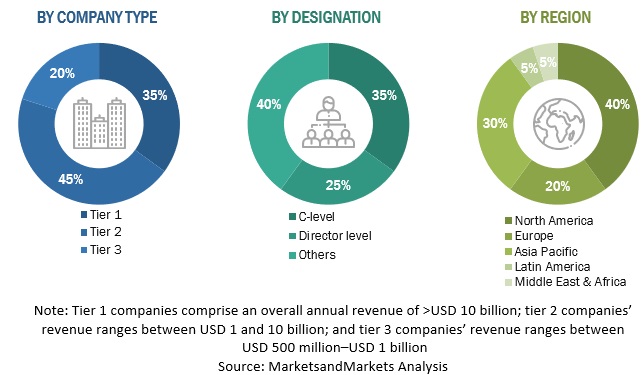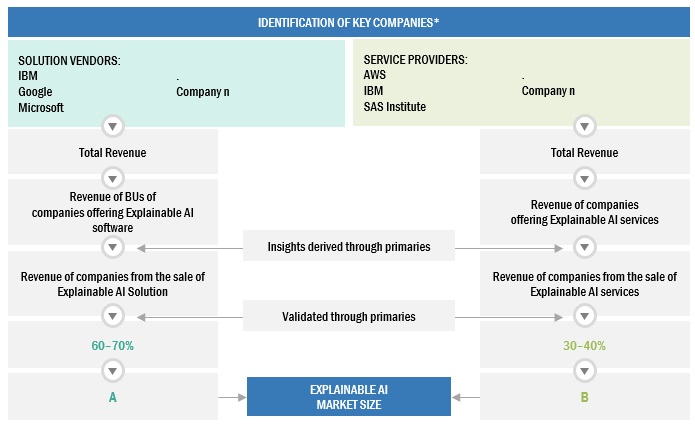The research study involved the use of extensive secondary sources, directories, as well as several journals and magazines such as the Institute of Electrical and Electronic Engineers IoT Journal, International Journal of Data Science and Analytics, and IoT Magazine to identify and collect the information useful for a comprehensive market research study on the explainable AI market. The primary sources were mainly industry experts from the core and related industries, preferred XAI solution providers, third-party service providers, consulting service providers, end users, and other commercial enterprises. In-depth interviews were conducted with various primary respondents, including key industry participants and subject matter experts, to obtain and verify critical qualitative and quantitative information, as well as assess the market’s prospects.
Secondary Research
In the secondary research process, various sources were referred to for identifying and collecting information for the study. The secondary sources included annual reports, press releases, investor presentations of companies, white papers, journals, and certified publications and articles from recognized authors, directories, and databases.
Primary Research
In the primary research process, various sources from both supply and demand sides were interviewed to obtain qualitative and quantitative information on the market. The primary sources from the supply side included various industry experts, including Chief Experience Officers (CXOs), Vice Presidents (VPs), directors from business development, marketing, product development/innovation teams, related key executives from explainable AI solution vendors, SIs, professional service providers, industry associations, and key opinion leaders. All possible parameters that affect the market covered in this research study have been accounted for, viewed in extensive detail, verified through primary research, and analyzed to get the final quantitative and qualitative data.
The following is the breakup of primary profiles:

To know about the assumptions considered for the study, download the pdf brochure
Market Size Estimation
Top-down and bottom-up approaches were used to estimate and validate the size of the global explainable AI market and various other dependent subsegments. The research methodology used to estimate the market size included the following details: the key players not limited to IBM, Microsoft, NVIDIA and Google in the market were identified through extensive secondary research, and their revenue contributions in the respective regions were determined through primary and secondary research. The entire procedure included the study of the annual and financial reports of top market players and extensive interviews for key insights from industry leaders, such as CEOs, VPs, directors, and marketing executives. All percentage splits and breakups were determined using secondary sources and verified through primary sources.
All the possible parameters that affect the market covered in the research study have been accounted for, viewed in extensive detail, verified through primary research, and analyzed to get the final quantitative and qualitative data. The data is consolidated and added with detailed inputs and analysis from MarketsandMarkets.
-
The pricing trend is assumed to vary over time.
-
All the forecasts are made with the standard assumption that the accepted currency is USD.
-
For the conversion of various currencies to USD, average historical exchange rates are used according to the year specified. For all the historical and current exchange rates required for calculations and currency conversions, the US Internal Revenue Service's website is used.
-
All the forecasts are made under the standard assumption that the globally accepted currency USD remains constant during the next five years.
-
Vendor-side analysis: The market size estimates of associated solutions and services are factored in from the vendor side by assuming an average of licensing and subscription-based models of leading and innovative vendors in the market.
-
Demand/end-user analysis: End users operating in verticals across regions are analyzed in terms of market spending on XAI solutions based on some of the key use cases. These factors for the XAI industry per region are separately analyzed, and the average spending was extrapolated with an approximation based on assumed weightage. This factor is derived by averaging various market influencers, including recent developments, regulations, mergers and acquisitions, enterprise/SME adoption, startup ecosystem, IT spending, technology propensity and maturity, use cases, and the estimated number of organizations per region.
Top-Down Approach
In the top-down approach, an exhaustive list of all the vendors offering solutions and services in the explainable AI market was prepared. The revenue contribution of the market vendors was estimated through annual reports, press releases, funding, investor presentations, paid databases, and primary interviews. Each vendor’s offerings were evaluated on the basis of the breadth of solutions and services, deployment modes, applications, and verticals. The aggregate of all the companies’ revenue was extrapolated to reach the overall market size. Each subsegment was studied and analyzed for its global market size and regional penetration. The markets were triangulated through both primary and secondary research. The primary procedure included extensive interviews for key insights from industry leaders, such as CIOs, CEOs, VPs, directors, and marketing executives. The market numbers were further triangulated with the existing MarketsandMarkets repository for validation.
Bottom-Up Approach
In the bottom-up approach, the adoption rate of explainable AI solutions among different end-users in key countries with respect to their regions that contribute the most to the market share was identified. For cross-validation, the adoption of explainable AI solutions and services among industries, along with different use cases with respect to their regions, was identified and extrapolated. Weightage was given to use cases identified in different regions for the market size calculation.
Based on the market numbers, the regional split was determined by primary and secondary sources. The procedure included the analysis of the explainable AI market’s regional penetration. Based on secondary research, the regional spending on Information and Communications Technology (ICT), socio-economic analysis of each country, strategic vendor analysis of major artificial intelligence providers, and organic and inorganic business development activities of regional and global players were estimated. With the data triangulation procedure and data validation through primaries, the exact values of the overall explainable AI market size and segments’ size were determined and confirmed using the study.

To know about the assumptions considered for the study, Request for Free Sample Report

Market Definition
According to IBM, Explainable AI is used to describe an AI model, its expected impact, and potential biases. It helps characterize model accuracy, fairness, transparency, and outcomes in AI-powered decision making. Explainable AI is crucial for an organization in building trust and confidence when putting AI models into production. AI explainability also helps an organization adopt a responsible approach to AI development.
Data Triangulation
After arriving at the overall market size using the market size estimation processes as explained above, the market was split into several segments and subsegments. To complete the overall market engineering process and arrive at the exact statistics of each market segment and subsegment, data triangulation, and market breakup procedures were employed, wherever applicable. The overall market size was then used in the top-down procedure to estimate the size of other individual markets via percentage splits of the market segmentation.
Key Stakeholders
-
Explainable AI solution providers
-
Independent software vendors (ISVs)
-
Investors and venture capitalists (VCs)
-
Managed service providers
-
Support and maintenance service providers
-
System integrators (SIs)/migration service providers
-
Value-added resellers (VARs) and distributors
Report Objectives
-
To determine and forecast the explainable AI market by offering, software type, methods, vertical, and region, and analyze the various macroeconomic and microeconomic factors that affect market growth.
-
To forecast the size of the market segments with respect to five main regions: North America, Europe, Asia Pacific, Middle East & Africa, and Latin America
-
To provide detailed information about the major factors influencing the growth of the market (drivers, restraints, opportunities, and challenges)
-
To analyze each submarket with respect to individual growth trends, prospects, and contributions to the overall market
-
To analyze the opportunities in the market for stakeholders by identifying the high-growth segments of the market
-
To profile the key market players and provide a comparative analysis on the basis of their business overviews, regional presence, product offerings, business strategies, and key financials, and illustrate the competitive landscape of the market
-
To track and analyze competitive developments, such as acquisitions; expansions; new product launches and product enhancements; agreements, collaborations, and partnerships; and R&D activities in the market.
Available Customizations
With the given market data, MarketsandMarkets offers customizations as per the company’s specific needs. The following customization options are available for the report:
Product Analysis
-
Product matrix provides a detailed comparison of the product portfolio of each company.
Geographic Analysis
-
Further breakup of the North American explainable AI market
-
Further breakup of the European market
-
Further breakup of the Asia Pacific market
-
Further breakup of the Latin American market
-
Further breakup of the Middle East & Africa explainable AI market
Company Information
-
Detailed analysis and profiling of additional market players up to 5



Growth opportunities and latent adjacency in Explainable AI Market